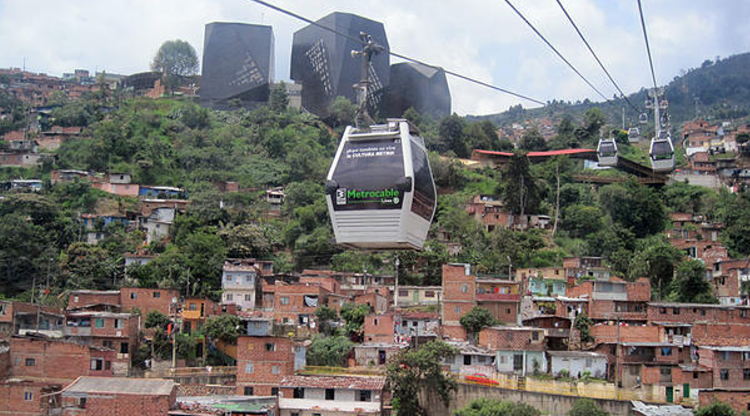Medellín has become emblematic of Colombia’s dramatic transformation over the past decade. But try telling that to residents of the city’s slums.

COLOMBIA NEWS JOURNAL – The labyrinth of streets making up Medellín’s hillside slums are filled with what locals here call an “apparent calm.” Food vendors are out in force, music blares from bars and shops, and old men sit outside sipping tiny plastic cups of coffee, watching the world go by. But behind these everyday scenes is the knowledge the peace in Colombia’s second-largest city could shatter at any moment.
In the first months of 2014, the murder rate in Medellín reached lows not seen since before the rise of its most notorious son, Pablo Escobar, 30 years earlier. While city authorities have been accepting the plaudits of the international community for their security achievements, residents and analysts say behind the reduced violence is a pax mafiosa that has strengthened the grip of criminal groups and cemented the city’s pivotal role in the international cocaine trade.
Medellín has become emblematic of Colombia’s dramatic transformation over the past decade. The city, once shorthand for drugs and violence, is now a thriving business hub, an up and coming tourist destination, and home to globally acclaimed urban policies.
But for residents in Medellín’s slums, who still live under the yoke of organized crime, the buzz and praise surrounding the city’s transformation has yet to become more than just rhetoric. Gang leaders and traffickers still reign supreme, and there are signs Medellín’s delicate peace is beginning to crack.
“You cannot talk about how everything has been transformed, how Medellín has changed when over 70 percent of the city [neighborhoods] are in the hands of criminals,” says Fernando Quijano, president of Medellín conflict monitoring group Corporation for Peace and Development (Corpades), which maps out gang presence and alliances in every neighborhood in the city.
Medellín remains a hive of criminal activity: drug sales in the city alone bring in an estimated $5.5 million a month, according to police estimates, and extortion of small businesses earns close to $2 million a month, according to business guild Fenalco. Medellín’s criminal elite still profit off the international cocaine trade, laundering much of the money in the city’s economy.
These criminal networks control the city’s underworld with young recruits from an often alienated and impoverished underclass. According to Corpades’s tracking of gang activity, there are an estimated 13,500 Medellín youths involved in around 350 gangs that answer to drug trafficking organizations. Police put the number of gangs at closer to 100.
‘Everything an urban conflict involves’
Since late 2011, there have been two criminal organizations struggling for control of Medellín. On one side stands the Urabeños, criminalized descendents of Colombia’s demobilized counter-insurgency paramilitary movement. On the other is the Oficina de Envigado, the successors of Pablo Escobar’s criminal empire.
For over a year and a half, the two sides waged war by arming gangs and paying them to seize and hold territory. The battle was fiercest in poor mountainside neighborhoods that act as bottlenecks for the movement of drugs and weapons.
“The victims have suffered from everything that an urban conflict involves; seeing families displaced, seeing friends die and relatives disappear,” says a community leader from one of the city’s worst affected areas, who did not want to be named for security reasons.
The confclit got bogged down in an expensive and bloody stalemate, and in July 2013 mafia leaders met to broker a truce. They divided up territories and, according to an official from Medellín’s Public Ministry, agreed to cooperate in international drug trafficking.
“[They agreed] the Urabeños would sell [cocaine] at cost price to the Oficina and they would share routes so that exports would be more efficient,” the official, who spoke on the condition of anonymity, says.
Since the pact came into force, the murder rate has tumbled; from 52 per 100,000 people killed in 2012, to 38 in 2013, and 28.5 at the start of 2014.
Medellín authorities insist the fall is predominantly a result of the deployment of a thousand extra police across the city, and the introduction of new policing techniques and technologies.
“This effectiveness [of city-wide security improvements] has led the criminals to say ‘they are hitting us hard so let’s be more peaceful and stop fighting among ourselves because we have a bigger enemy – the state,’ ” Jorge Mejia, the mayor’s office counselor for coexistence, reconciliation, and life, says.
However, residents of gang controlled areas dispute this. Nights are no longer filled with the sound of gunfire, but residents say criminal control of their neighborhoods has in fact increased during the pact. Minors are still threatened and recruited, the rate of extortion and other crimes have started going up again, and disappearances are on the rise.
With the pact reaching its first year anniversary this month, shootouts have again become common in strategic locations, and residents in conflict hotspots report that powerful gangs are preparing for a new round of fighting.
“There are a lot of rumors [about what will happen next] and the war drums are sounding,” says Mr. Quijano, from Corpades.
Mr. Mejia insists an uptick in violence does not undermine Medellín’s transformation.
“Maintaining the rhythm of the reduction in homicides is not easy because organized crime has not disappeared,” he says. “It may be calmer, it may be focused on something else, but it’s still there.
“But that does not mean Medellín has gone back to how it was years ago,” Mejia says.
Source: Christian Science Monitor
